Last updated: April 12, 2023
Article
Fort Pickens and the Outbreak of the Civil War (Teaching with Historic Places)
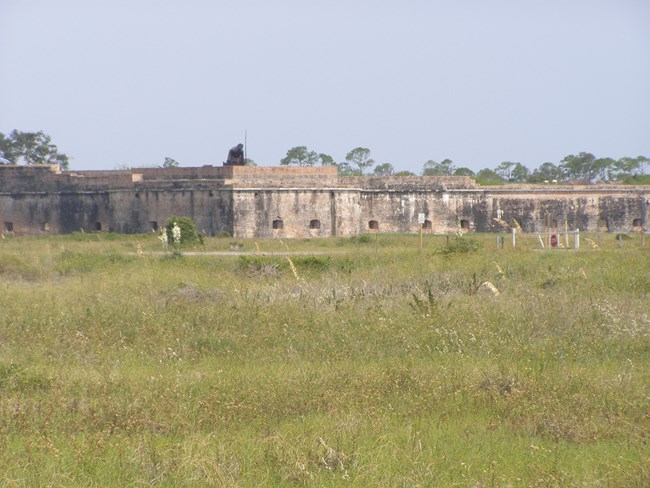
Chris Light
This lesson is part of the National Park Service’s Teaching with Historic Places (TwHP) program.
The peaceful surroundings--white sugar-sand beaches, clumps of golden sea oats, and the soothing sounds of coastal waves pounding on the shores of a long barrier island--belie the serious purpose of Fort Pickens, located on Santa Rosa Island in Florida. One of the largest brick forts built in the United States, Fort Pickens provided the setting for a serious conflict right before the outbreak of the Civil War. Months before the firing on Fort Sumter, the secessionist forces at nearby Pensacola, Florida, tried to capture the fort from the U.S. Army without initiating bloodshed.
Fort Pickens and nearby Fort McRee, Fort Barrancas, and Advanced Redoubt today lie within Gulf Islands National Seashore. They provide an intriguing setting for the important events that occurred in the Pensacola area just prior to and during the Civil War.
About This Lesson
This lesson is based on the National Register of Historic Places registration files "Fort Pickens" (with photographs) and "Fort Barrancas Historic District" (with photographs), and on historic structure reports for both forts. It was written by Ann Marie Folker, a Park Ranger at Gulf Islands National Seashore. The lesson was edited by Fay Metcalf and the Teaching with Historic Places staff. TwHP is sponsored, in part, by the Cultural Resources Training Initiative and Parks as Classrooms programs of the National Park Service. This lesson is one in a series that brings the important stories of historic places into the classrooms across the country.
Where it fits into the curriculum
Time Period: 1820s-1860s
Topics: This lesson could be used in teaching units on the Civil War in U.S. history.
United States History Standards for Grades 5-12
Fort Pickens and the Outbreak of the Civil War
relates to the following National Standards for History:
Era 5: Civil War and Reconstruction (1850-1877)
- Standard 1A: The student understands how the North and South differed and how politics and ideologies led to the Civil War.
- Standard 2A: The student understands how the resources of the Union and Confederacy affected the course of the war.
- Standard 2B: The student understands the social experience of the war on the battlefield and homefront.
Curriculum Standards for Social Studies
National Council for the Social Studies
Fort Pickens and the Outbreak of the Civil War
relates to the following Social Studies Standards:
Theme I: Culture
- Standard B - The student explains how information and experiences may be interpreted by people from diverse cultural perspectives and frames of reference.
Theme II: Time, Continuity and Change
- Standard D - The student identifies and uses processes important to reconstructing and reinterpreting the past, such as using a variety of sources, providing, validating, and weighing evidence for claims, checking credibility of sources, and searching for causality.
Theme III: People, Places, and Environment
-
Standard A - The student elaborates mental maps of locales, regions, and the world that demonstrate understanding of relative location, direction, size, and shape.
Theme V: Individuals, Groups, and Institutions
- Standard E - The student identifies and describes examples of tensions between belief systems and government policies and laws.
Theme VI: Power, Authority, and Governance
- Standard C - The student analyzes and explains ideas and governmental mechanisms to meet needs and wants of citizens, regulate territory, manage conflict, and establish order and security.
- Standard D - The student describes the ways nations and organizations respond to forces of unity and diversity affecting order and security.
Objectives for students
1) Describe events in the region of Pensacola, Florida, that preceded the Civil War;
2) Examine the role of Fort Pickens prior to and during the Civil War;
3) Evaluate decisions made by key individuals in Pensacola in 1861, and to describe the consequences of those decisions;
4) Investigate the impact of military installations in their own community.
Materials for students
The materials listed below can either be used directly on the computer or can be printed out, photocopied, and distributed to students.
1) One map of harbor defenses for Pensacola, Florida, 1861;
2) Three readings about the defense sites and important historical figures in the Pensacola area at the outbreak of the Civil War;
3) One photo and one diagram of Fort Pickens and its design;
4) One photo and one diagram of Fort Barrancas and its design.
Visiting the site
Gulf Islands National Seashore, administered by the National Park Service, comprises several sites. Fort Pickens is located at the tip of Santa Rosa Island along Fort Pickens Road, west of Pensacola Beach, Florida. The park is open year-round, although operating hours vary seasonally. For additional Teaching with Historic Places National Park Service U.S. Department of the Interior Fort Pickens and the Outbreak of the Civil War information, write the Superintendent, Gulf Islands National Seashore, 1801 Gulf Breeze Parkway, Gulf Breeze, FL 32561, or visit the park's website.
Getting Started
Inquiry Question
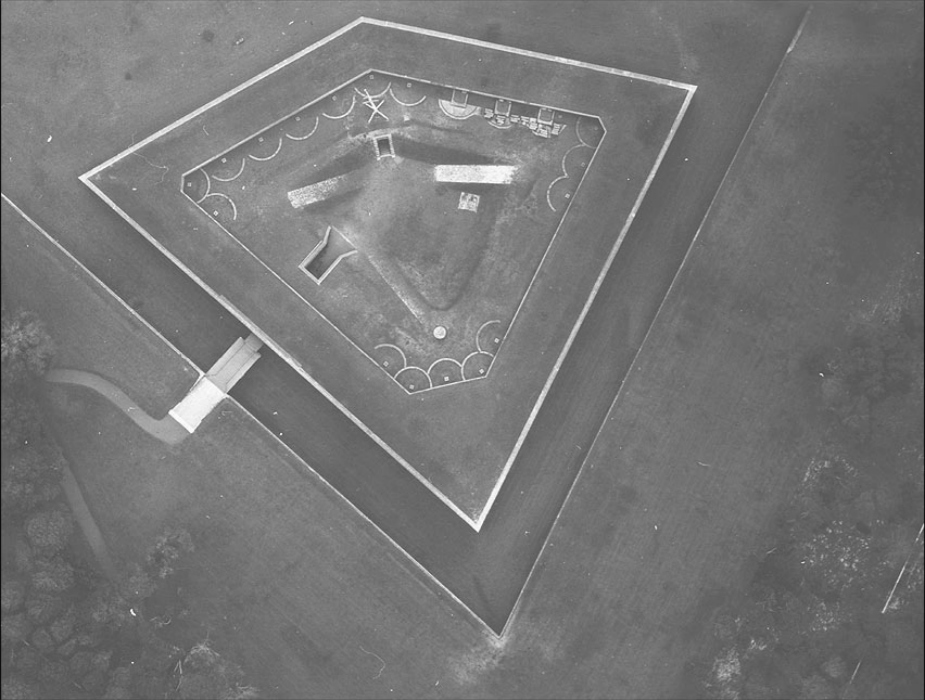
Gulf Islands National Seashore
What might this structure be? What do you think it was used for?
Setting the Stage
Pensacola, Florida, is located on one of the best deep water harbors on the Gulf Coast. Large ships can pass through the entrance and enter the protected bay. The Spanish, French, English, and the Americans recognized that Pensacola Bay’s entrance provided the key to the defense of Florida’s panhandle. When Spain ceded Florida to the United States in 1819, the U.S. Navy selected Pensacola Bay as the site for a navy yard.
Beginning in 1829, Americans built four forts in the area--Pickens (1829-34), McRee (1835-39), Barrancas (1839-44), and the Advanced Redoubt (1845-56)--to defend Pensacola and its navy yard from possible attacks by foreign powers. The strategy was to build up defenses that appeared so formidable an enemy would be deterred from attacking. At Pensacola this buildup was successful as no foreign country ever did attack the forts. The American Civil War, however, made for a different story.
Locating the Site
Map 1: 1861 map of harbor defenses for Pensacola, Florida
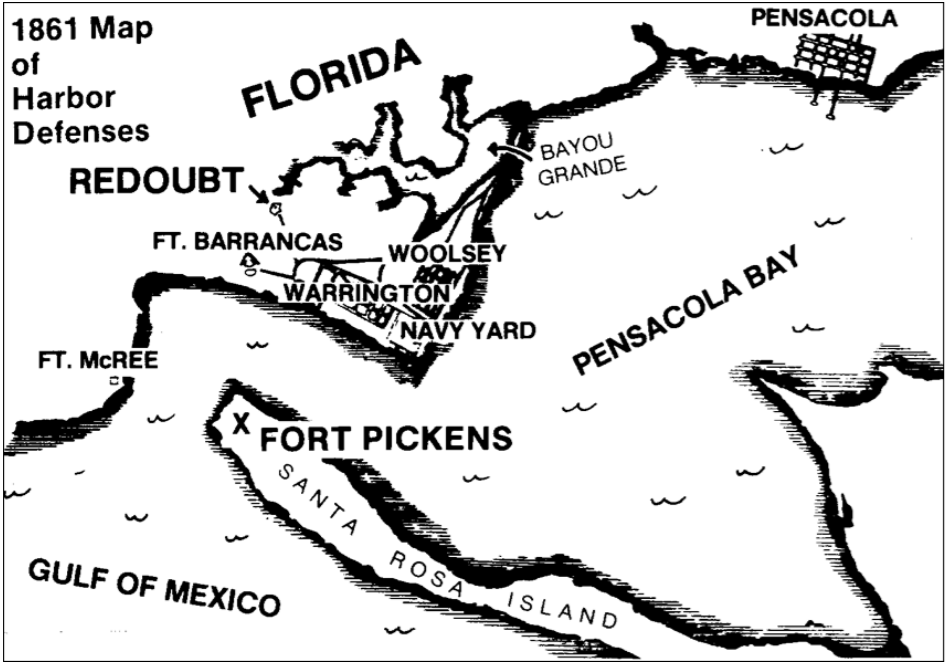
National Park Service
The channel entrance to Pensacola Bay on the west end of Santa Rosa Island was fortified since the east end is too shallow for larger ships to pass through. Fort Pickens was sited both to protect Santa Rosa Island and to prevent enemy ships from entering the bay and anchoring within range of the navy yard.
Questions for Map 1
1) On a map of the United States, find the panhandle of Florida and the far western location of Pensacola.
2) Examine the map and suggest reasons why the four forts and the navy yard were built in their specific locations (consider the role of existing military technology).
3) Draw circles about the size of a dime with each fort as the center of its circle. These circles represent the approximate area that could be protected by the cannon that were emplaced at these forts in the 19th century. How could the forts have assisted each other in defending the bay entrance from an attacking ship?
4) Why might an invader choose a landward assault? Identify which of the installations might have been designed to protect the navy yard against a land attack.
Determining the Facts
Reading 1: The Civil War in Pensacola Area
When Abraham Lincoln won the presidential election of 1860, many white Southerners responded with fear and anger. Although Lincoln had never called for abolishing slavery altogether, stating only that it should not spread to the territories, few white Southerners believed him. They were certain Lincoln did plan to end slavery, and Southern radicals called for the South to secede from the Union. South Carolina announced its secession in December 1860, even before Lincoln took office. Within six weeks Mississippi, Florida, Alabama, Georgia, Louisiana, and Texas voted to leave the Union. These states justified their secession on the basis that because the states had voluntarily joined the Union, they also could leave it whenever they chose.
Pensacola Bay with its safe harbor and adjoining navy yard complete with docking, supply, and shipbuilding facilities would be a valuable prize for either side if war broke out between the U.S.A. and the emerging Confederate States of America. The four brick forts which had been built byenslaved laborers to protect the bay’s entrance from possible foreign attack would be part of the prize: Fort Pickens on the western end of Santa Rosa Island, Fort McRee to the west across the ship channel, and Fort Barrancas and its Advanced Redoubt on the mainland.
Stationed at Fort Barrancas, U.S. Army Lieutenant Adam J. Slemmer realized that if war proved inevitable and secessionist forces attacked, his small force of 51 men could not possibly defend all four forts. On January 10, 1861, the same day Florida seceded from the Union, he concentrated all his troops in Fort Pickens, which he believed was the key to the defense of Pensacola’s harbor. Two days later, Slemmer’s men watched as secessionist soldiers moved into the other forts across the channel, removing the U.S. flags. Then, on January 15, soldiers from Florida and Alabama demanded the surrender of Fort Pickens. Lieutenant Slemmer refused. On January 28, 1861, a truce was reached that stated that the South would not attack and Fort Pickens would not be reinforced.
By the time Lincoln took office in March, both Fort Sumter in the harbor of Charleston, South Carolina, and Fort Pickens, needed supplies. In his inaugural address Lincoln had pledged to continue to occupy federal property in the seceded states. If he withdrew the garrisons at those forts it would mean he officially recognized the Confederacy and its right to occupy those posts; if, on the other hand, he supplied the forts, he risked war.
The Union did send ships filled with supplies and reinforcements from Fort Monroe, Virginia, to Fort Pickens, but under terms of the truce they dared not land. For 10 weeks, the U.S. ships with blue coated soldiers aboard lay at anchor near Fort Pickens, while inside the fort, fearful of a surprise assault on the island, Lieutenant Slemmer kept his command on full alert. The Confederates had in fact planned such a surprise attack, but bad weather delayed them until the 12th of April. Then, before they could get under way, they learned that South Carolina forces had opened fire on Fort Sumter. The civil war so many had feared for so long became a reality.
Soon more Union ships with supplies and troops arrived off Fort Pickens. By the summer of 1861, the fort was still firmly under Union control, and the U.S. Navy blockaded Pensacola’s harbor. Colonel Harvey Brown, now in command of Fort Pickens, and his thousand or more soldiers strengthened the island’s defenses by building gun emplacements, mounting guns, drilling, and moving supplies from ships to the fort.
The Confederate forces under the command of Gen. Braxton Bragg, now several thousand strong, kept equally busy. Though they were fresh troops, they made up for their lack of training by their great enthusiasm. The Confederate lines stretched for four miles, from Fort McRee on the west, eastward to Fort Barrancas and the navy yard. It was at the navy yard that the first fighting took place between the two armies. On September 13, 1861, a force of 100 Union sailors and marines crossed the bay and set fire to the Confederate ship, Judah.
Before dawn, on October 9, more than 1,000 Confederates landed four miles east of Fort Pickens and advanced against the Union lines. Darkness provided surprise but some soldiers lost their way among the sand dunes and scrub vegetation. One Union camp was taken and burned, but the approaching dawn and fear of Union gunboat attacks on their transport boats led the Confederates to withdraw eastward toward their landing place. In the meantime, Union troops from Fort Pickens counterattacked and the battle became a running skirmish down the island. Finally, the Confederates reached their boats and rapidly crossed the bay to safety. Known as the Battle of Santa Rosa Island, this confrontation was one of the first significant land battles of the Civil War fought in Florida.
Colonel Brown termed the attack a "gross insult to the flag" and was determined to punish the Confederates through a massive display of Union firepower from both Fort Pickens and ships in the gulf. At 10 a.m. Saturday morning, November 22, 1861, an all-day bombardment began. The Confederates did not wait long to respond. The next day both sides continued their bombardments. During those two days, 5,000 Union and 1,000 Confederate projectiles were fired from the big guns. The noise staggered the imagination. So enormous were the reverberations from the firepower that thousands of dead fish floated to the surface of Pensacola Bay, and windows shattered seven miles away in the town of Pensacola. When the bombardment ended late on November 23, little had been gained or lost by either side. At Fort Pickens, one man had been killed by enemy fire and two guns had been disabled (one had burst from too much use). The Confederates did not suffer many casualties or loss of equipment either, despite the fierce bombardment. Fort McRee was heavily damaged, however.
The U.S. army obtained control of Pensacola’s harbor in May 1862--not as a consequence of the battle, but through the Confederates’ decision to abandon the harbor and remove more than 10,000 of their soldiers from the region beginning in February. The Union forces took control of the deserted navy yard and the nearby forts, and they held Pensacola for the remainder of the Civil War. All the forts defending Pensacola’s harbor once again flew the U.S. flag, and their defenders saw limited fighting during the rest of the Civil War. Instead, the forts acted as an important base of operations for raids into Florida and Alabama and as a prison for military and political prisoners.
Questions for Reading 1
1) Why was Pensacola Bay considered an important prize in the Civil War?
2) Why did the Union forces believe it was vital to hold control of Fort Pickens?
3) How did the role of Fort Pickens during the war differ from its original purpose?
4) How were events in the Pensacola area just before the outbreak of the Civil War similar to those at Fort Sumter? How were they different? (Use a U.S. history textbook for background information on Ft. Sumter).
5) How did the Union army finally gain full control of Pensacola Harbor?
Determining the Facts
Reading 2: Major Chase Versus Lieutenant Slemmer
A Profile of William Chase
From 1829 until his death in 1870, Maj. William Chase of the U.S. Army Corps of Engineers ran multiple businesses in the town of Pensacola, often using enslaved labor. As part of his military command, Chase also helped to plan and build U.S. defenses on the Gulf of Mexico, including the four Pensacola forts.
In 1861 when the Southern states had decided to secede from the Union and civil war seemed imminent, Chase decided to serve as commander of the Florida contingent of secessionist troops. By using surprise, deception, and overwhelming superiority in force, secessionist troops bloodlessly occupied the Pensacola navy yard and found Fort Barrancas, Fort McRee, and the Advanced Redoubt already abandoned by Lt. Adam Slemmer. Chase also hoped to take control of Fort Pickens because it controlled access to the harbor of Pensacola. The Union soldiers at Fort Pickens knew this as well as Chase did, however, and they refused to turn the key fort over to the secessionists. They knew that even though the secessionists might control the other forts, they could not use the bay as long as the Union held Fort Pickens. On January 15, 1861, Chase went to Fort Pickens in person to try to persuade Slemmer to surrender. When he was unsuccessful, Chase reported to Confederate President Jefferson Davis that in order to take Fort Pickens troops would have to scale the walls. That action would guarantee a loss of life and would bring on civil war. Chase left things as they were for the time being.
Compiled from Edwin C. Bearss, "Historic Structure Report, Fort Pickens, Historical Data Section, 1821-1895, Gulf Islands National Seashore, Florida-Mississippi," U.S. Department of the Interior, National Park Service, 1983.
The following dialogue was written by U.S. Lt. Jeremiah H. Gilman, who witnessed the encounter between Chase and Slemmer. He wrote this dialogue twenty-five years later.
Fort Pickens, January 15, 1861
Chase: I have come on business which may occupy some time, and, if you have no objection, we had better go inside to your quarters.
Slemmer: I have objection, and it could hardly be expected that I would take you into the fort.
Chase: As I built the fort and know all its weak and strong points, I would learn nothing new by going in, and had no such object in proposing it.
Slemmer: I understand that perfectly, but it would be improper for me to take you in; and, however well you have known the fort before, you do not know what it now contains, nor what I have done inside.
Chase: That is true and I will state my business here. It is a most distressing duty to me. I have come to ask of you young officers, officers of the same army in which I have spent the best and happiest years of my life, the surrender of this fort. I would not ask it if I did not believe it right and necessary to save bloodshed; and fearing that I might not be able to say it as I ought, and in order, also, that you may have it in proper form, I have put it in writing and will read it. [Chase then takes the manuscript from his pocket and begins to read, but, after reading two or three lines, his voice shakes, and his eyes fill with tears. He stamps his foot and says] I can’t read it. Here Farrand, you read it. [He hands the paper to Commander Ebenezer Farrand.]
Farrand [takes the paper and remarks]: I do not have my glasses. [He then passes the paper to Lieutenant Jeremiah H. Gilman.]
Gilman [who had chosen to stand by the Union, reading for Chase]: I have full powers from the governor of Florida to take possession of the forts and navy yard in his harbor. I desire to perform this duty without the effusion of blood. You can contribute toward this desirable result, and in my judgment, without sacrifice of the honor of yourself or your gallant officers and men. Now, as commissioner on the part of the governor of the State of Florida, I request the surrender of Fort Pickens and the public property it contains into my hands, to be held subject to any agreement that may be entered into between the commissioners of the State of Florida and the federal government at Washington.... If the Union now broken should be reconstructed Fort Pickens and all the public property passes peacefully under federal authority. If a Southern Confederacy separates itself from the Union would it not be worse than folly to attempt the maintenance of Fort Pickens or any other fortified place within its limits?
Slemmer: Colonel, how many men have you?
Chase: Tonight I shall have between eight and nine hundred.
Slemmer: Do you imagine you could take this fort with that number?
Chase: I certainly do. I could carry it by storm. I know every inch of this fort and its condition.
Slemmer: With your knowledge of the fort and of your troops, what proportion of them, do you imagine, would be killed in such an attack?
Chase [shrugging his shoulders]: If you have made the best possible preparation, as I suppose you have, and should defend it, as I presume you would, I might lose one-half my men.
Slemmer: At least, and I don’t believe you are prepared to sacrifice that many men for such a purpose.
Chase: You must know very well that, with your small force, you are not expected to, and cannot, hold this fort. Florida cannot permit it, and the troops here are determined to have it; and if not surrendered peacefully, an attack and the inauguration of civil war cannot be prevented. If it is a question of numbers, and 800 is not enough, I can easily bring thousands more.
Slemmer: I will give this letter due consideration...I will give you my answer tomorrow morning.
[Pause, Confederates exit stage. Then Farrand returns--this time with his glasses on--stating he has received a letter (from Slemmer) addressed to Chase, which he reads:]
Farrand: Under the orders we now have from the War Department, we have decided...that it is our duty to hold our position until such a force is brought against us as to render it impossible to defend it, or until the political condition of the country is such as to induce us to surrender the public property in our keeping to such authorities as may be delegated legally to receive it. We deprecate as much as you or any individual can the present condition of affairs, or the shedding of the blood of our brethren. In regard to this matter, however, we must consider you the aggressors and if blood is shed that you are responsible therefore.
From Jeremiah H. Gilman, "With Slemmer in Pensacola Harbor," in Robert Underwood Johnson and Clarence Clough Buel, eds., Battles and Leaders of the Civil War, vol. 1, 1887, 30-31.
Questions for Reading 2
1) Why would Chase have felt concern over the fate of Fort Pickens?
2) Why would Lieutenant Slemmer have felt obligated to protect the fort? List reasons why he should not have surrendered Fort Pickens.
3) Do you think that under different circumstances the men involved in this incident might have been friends?
4) How accurate do you think Gilman’s account is to what really happened?
Determining the Facts
Reading 3: Key People and Critical Decisions
Quotation 1
When once constructed, they [the forts] require but little expenditure for their support. In time of peace, they withdraw no valuable citizens from the useful occupations of life. Of themselves, they can never exert an influence dangerous to public liberty; but as a means of preserving peace, and as obstacles to an invader, their influence and power are immense.1
--Lieutenant Henry W. Halleck, U.S. Army, 1843
Quotation 2
I called on Commodore Armstrong (Union Commanding Officer of the Navy Yard).... He had received orders to cooperate with me. We decided that with our limited means of defense we could hold but one fort, and that should be Fort Pickens, as it commanded completely the harbor and the forts and also the Navy Yard.2
--Lieutenant Adam J. Slemmer, U.S. Army, January 1861
Quotation 3
We [the seceding states] seek not to war upon or conquer you; and we know that you cannot conquer us. Imbrue [stain] your hands in our blood, and the rains of a century will not wash from your hands the stain, while coming generations will weep for your wickedness and folly.3
--Florida Senator Stephen R. Mallory, Chairman of the Senate Committee on Naval Affairs, just prior to his resignation from the U.S. Congress, February 1861
Quotation 4
...the possession of the fort [Fort Pickens] is not worth one drop of blood to us...4
--Stephen R. Mallory, secretary of the Confederate navy, 1861
Questions for Reading 3
Quotation 1:
1) In planning the nation’s defenses, how would you decide whether to train thousands of soldiers (mass mobilization) for the threat of war or spend thousands of dollars (purchase defense) on the construction of immense forts that might never be needed?
2) Only about 50 soldiers were stationed in the area of Fort Barrancas in January 1861. Why do you think there were so few men there?
Quotation 2
1) If you were Lieutenant Slemmer, how would you have located your soldiers and supplies among the forts in January 1861? Why?
2) If you were Lieutenant Slemmer, would you have surrendered when faced with the Confederate’s demand? Why or why not?
Quotations 3 and 4
1) Stephen R. Mallory, a former U.S. Senator and a Pensacola citizen, attempted to secede from the U.S. without causing a war. He was instrumental in producing the "Truce of Fort Pickens" on January 28, 1861, which stated that the secessionists would not attack and Fort Pickens would not be reinforced. List reasons why Mallory might have wanted to avoid a civil war. Do you think this was a realistic expectation?
Visual Evidence
Photo 1: Aerial view of Fort Pickens, c. 1970
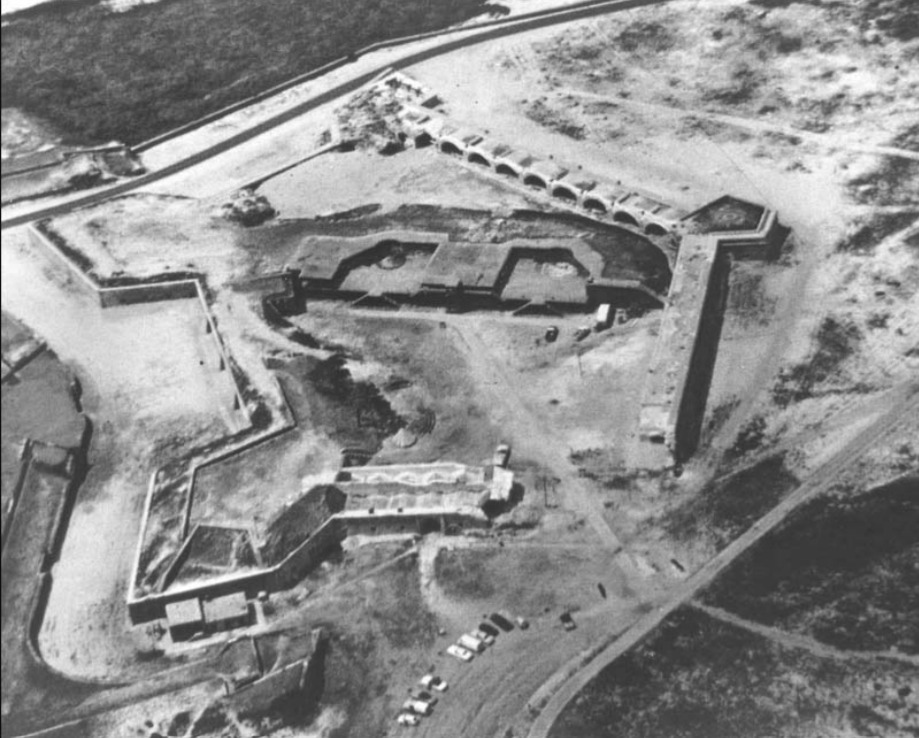
Gulf Islands National Seashore
Visual Evidence
Diagram 1: Fort Pickens
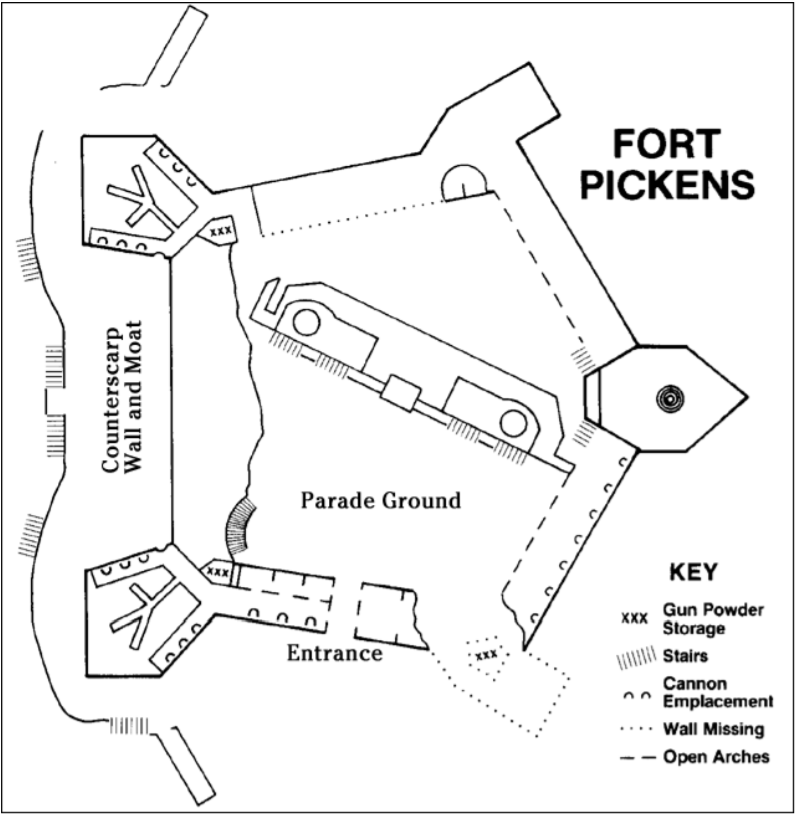
Gulf Islands National Seashore
Questions for Photo 1 and Diagram 1
1) Why do you think the corners of Fort Pickens projected outward?
2) Using Map 1 as a reference, label Diagram 1 of Fort Pickens with the directions north, south, east and west as you believe the fort was sited. Why do you think the fort was positioned in the manner you chose?
Visual Evidence
Photo 2: Aerial view of Fort Barrancas, c. 1983

Gulf Islands National Seashore
Diagram 2: Fort Barrancas
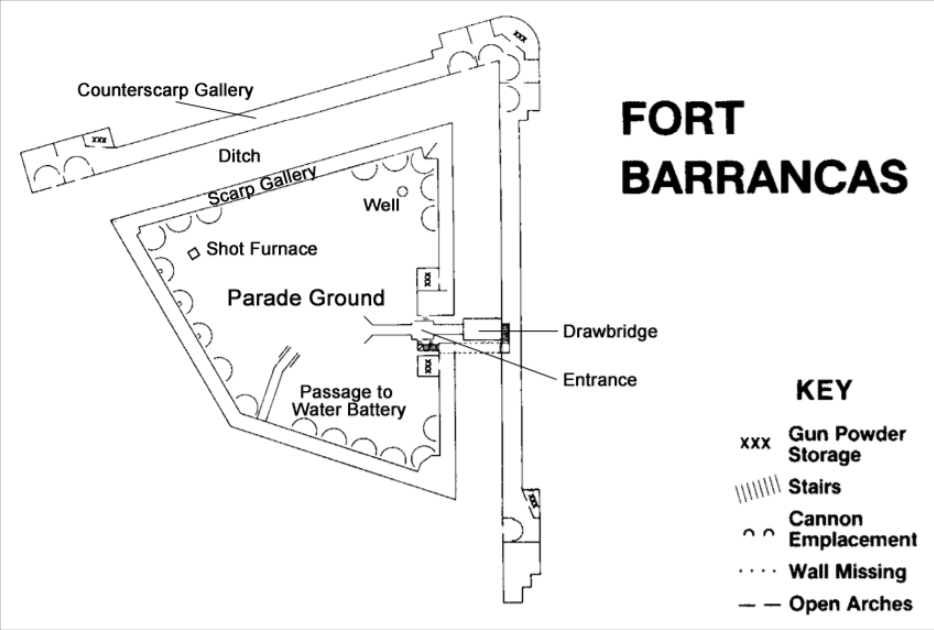
Gulf Islands National Seashore
Questions for Photos 2 and Diagram 2
1) Using Map 1 as a reference, label Diagram 2 of Fort Barrancas with the directions north, south, east and west as you believe the fort was sited. Why do you think the fort was positioned in the manner you chose?
2) Compare Photo 1 and Diagram 1 with Photo 2 and Diagram 2. What are some similarities and differences between the two forts? What are some factors that may account for the differences?
Putting It All Together
The following activities explore issues related to events in the Pensacola area at the outbreak of the Civil War and military installations in the local community.
Activity 1: Surrender or Not
Provide students with copies of Reading 2 and ask them to re-read "A Profile of William Chase." Remind students that Florida seceded from the U.S. on January 10, 1861, and would join the alliance that became the Confederate States of America. Have the class discuss the tactics that Chase uses to try to persuade Slemmer. Now ask students to consider Jeremiah H. Gilman, the author of that dialogue. Gilman was a U.S. Lieutenant at Pensacola and was likely present at that meeting. What do they think were Gilman's sources for the dialogue: interviews with other people, his memory, written notes, etc.? What do they think was Gilman's motivation in writing the dialogue? How accurate do students think the dialogue was to what actually happened? What other sources that might exist would make students more confident that Gilman’s dialogue represents what really happened? These sources could include photographs, other first-person accounts, artifacts, etc.
Activity 2: Researching Pensacola in the Civil War
Divide the class into small groups. Have each group find a reference to Fort Sumter in a history textbook or an encyclopedia. Now look up Fort Pickens. Why might Fort Pickens have been the site of the start of the Civil War just as easily as Fort Sumter? After adequate preparation time, have the class listen as each group defends its answer. Groups may also make their arguments in an organized debate.
Activity 3: Isn’t It Ironic?
There were many ironies connected with activities in the Pensacola area in the 19th century. Use one or two of those listed below as examples and then ask students to list others. See how many ironies they can find.
- The forts were built to protect the U.S. from the threat of foreign attack. The forts, however, saw action only during the Civil War when Americans fought among themselves.
- William Chase supervised the construction of Fort Pickens (1829-1834). In 1861 he found himself asking for the fort’s surrender. When the Union refused, he had to decide whether or not to attack the very fort he helped build.
- Contracted enslaved laborers built the Pensacola forts. In 1861 enslaved people who built Fort Pickens crossed the bay to tell the Union about the fort’s weaknesses. Fort Pickens’ only active use was during the Civil War, a war that set its enslaved builders free.
- Fort McRee is now destroyed primarily due to the forces of nature, not humans.
Activity 4: Installations in the Local Community
Ask students to research their own community (or region if necessary) to determine if there is a military base in the area. Have them answer the following questions: When was it established? Why was it established? Approximately how many military personnel are stationed at the base? What impact has the base had on the growth and development of the surrounding communities? How might these communities be affected if the military base was to close? Hold a classroom discussion based on the students’ findings.
Additional Resources
By looking at Fort Pickens and the Outbreak of the Civil War, students discover why Fort Pickens was so valuable to both the Union and Confederacy, and follow the actions of the military commanders faced with crucial decisions. Those interested in learning more will find that the Internet offers a variety of interesting materials.
Gulf Islands National Seashore
Fort Pickens and Fort Barrancas are part of Gulf Islands National Seashore, which is a unit of the National Park System. Visit the park's web pages to learn more about the park and its history.
Florida Department of State, Division of Historical Resources
The Florida Maritime Heritage Trail offers histories, photographs, and maps of the many forts that protected the Florida shores, including Fort Pickens, Fort McRee, and Fort Barrancas.
Historic American Buildings Survey/ Historic American Engineering Record (HABS/HAER)
The HABS/HAER collections document achievements in architecture, engineering, and design in the United States through a comprehensive range of building types and engineering technologies. Search the collection for documentation on numerous forts, including Fort Barrancas. Drawings and photographs, as well as historical data are provided.
The American Battlefield Protection Program
The American Battlefield Protection Program, a division of the National Park Service, provides detailed on-line publications featuring different topics in the Civil War. Included is a battle summary of the Battle of Santa Rosa Island.
National Park Service Civil War Website
Visit the official National Park Service Civil War website. Offering the current generation of Americans an opportunity to know, discuss, and commemorate this country's greatest national crisis, while at the same time exploring its enduring relevance in the present, the website includes a variety of helpful features such as a timeline and stories from various perspectives. Also included are links to Civil War Parks, NPS education programs, and much more.
Civil War Soldiers & Sailors System
The National Park Service's Civil War Soldiers & Sailors database contains facts about Civil War servicemen, lists of Civil War regiments, and descriptions of significant Civil War battles. Also on this site is a descriptive history of African Americans in the Civil War.
National Archives and Records Administration
The National Archives and Records Administration offers a wealth of information about the Civil War. Use the search engine to access a special collection of photographs covering many aspects of the Civil War. Also search on "Civil War records" to locate comprehensive Union and Confederate records.
Library of Congress
The Library of Congress created a selected Civil War photographic history in their digital collections. Included on the site is a photographic time line of the Civil War covering major events for each year of the war.
The American Civil War Museum
The American Civil War Museum is a center to explore the war and its legacies from multiple perspectives. Their website contains photographs, flags, and online exhibits.
